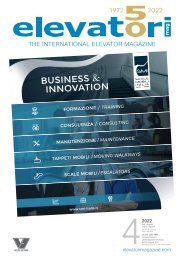Create successful ePaper yourself
Turn your PDF publications into a flip-book with our unique Google optimized e-Paper software.
Topical subjects<br />
Attualità<br />
Tall buildings:<br />
the discussion starts again<br />
Edifici alti, il dibattito<br />
riprende… e raddoppia<br />
Aldo Norsa & Dario Trabucco<br />
While cities all over the world,<br />
including Italy, are still wondering how<br />
to actually get out of the challenges<br />
caused by the Covid-19 pandemic, some positive<br />
signals and interesting typomorphological<br />
indications are arriving from the planning sector.<br />
These give hope for a continuation<br />
of urban densification interventions, which,<br />
over the last few years, have been producing<br />
interesting results both in Italy and in Europe<br />
(leaving more and more room for land<br />
equipped for the liveability and leisure time<br />
of citizens).<br />
This is the meaning we should give to the result<br />
of the recent competition for the design<br />
of the headquarters of the Sicily Region.<br />
The winning project, presented by the Italian<br />
company Tekne and the French Leclercq<br />
Associés, looks like an interesting structure<br />
fragmented into several overlapping building<br />
blocks. All the competing projects, however,<br />
move towards a vertical development, proposing<br />
this type of building for the Sicilian capital,<br />
which has now become part of the skyline<br />
of medium-sized cities. Such as the (single,<br />
iconic) skyscrapers built in Bologna and Padua<br />
in the last decade.<br />
In continuity with the past (and with no real<br />
discontinuity caused by the pandemic)<br />
there are various projects under construction<br />
or development in Milan, the city that has been<br />
symbolising the skyscraper in Italy since the<br />
‘roaring’ 1960s. The Lombard capital remains<br />
Mentre le città di tutto il pianeta,<br />
comprese ovviamente quelle italiane,<br />
si stanno ancora chiedendo come<br />
uscire effettivamente dai problemi creati dalla<br />
pandemia di Covid-19, arrivano dal mondo della<br />
progettazione alcuni positivi segnali e indicazioni<br />
tipomorfologiche da seguire con interesse.<br />
Questi fanno sperare in una continuazione degli<br />
interventi di densificazione urbana, che abbiamo<br />
visto nel corso degli ultimi anni produrre<br />
interessanti risultati sia in Italia che in Europa<br />
(lasciando sempre più spazio ai suoli attrezzati<br />
per la vivibilità e il tempo libero dei cittadini).<br />
In questo senso va letto, per esempio, il risultato<br />
del recente concorso per la progettazione<br />
della sede unica della Regione Sicilia. Il progetto<br />
vincitore, presentato dalla società italiana Tekne<br />
e dalla francese Leclercq Associés, si presenta<br />
come un interessante volume frammentato in<br />
diversi blocchi edilizi sovrapposti. Tutti i progetti<br />
presentati dai concorrenti vanno comunque nella<br />
direzione dello sviluppo verticale, proponendo<br />
anche per il capoluogo siciliano questo<br />
tipo edilizio, oramai diventato patrimonio<br />
dello skyline anche di città di medie dimensioni.<br />
Si pensi ai grattacieli (singoli e iconici) realizzati<br />
nell’ultimo decennio a Bologna e a Padova.<br />
In continuità con il passato (e senza vera<br />
discontinuità causata dalla pandemia) numerosi<br />
sono anche in questo momento i progetti<br />
in fase di realizzazione o sviluppo a Milano, città<br />
simbolo in Italia del grattacielo sin dai ‘ruggenti’<br />
anni ’60. Il capoluogo lombardo rimane al centro<br />
20 ELEVATORIMAGAZINE.COM <strong>2021</strong> JULY | AUGUST • LUGLIO | AGOSTO <strong>2021</strong>














